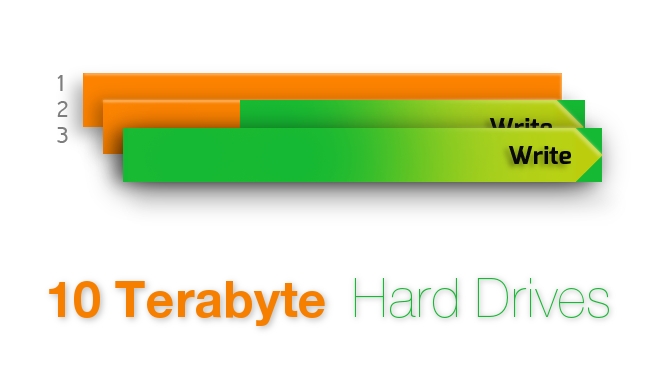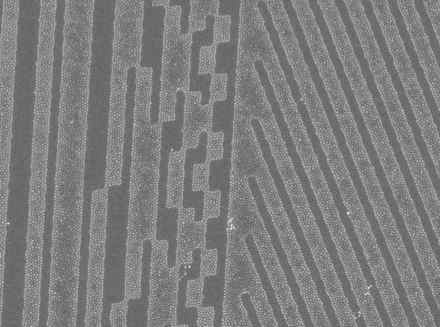
 Shingled Recording
Shingled Recording
Redshark News Technical Editor Phil Rhodes reveals how shingled recording has led to the production of bigger, faster hard drives.
Storage has come quite a way since the days of the BBC's VERA, the first magnetic video recorder, which used steel wire to record video signals and, therefore, required huge spools which revolved at incredible speed. Hard disks, which we could crudely describe as a cross between a magnetic tape recorder and a record player, also spin at huge speeds, and continue to fight off the advances of solid-state storage with technological innovations of their own.
Current devices, for instance, generally use a technique called perpendicular recording, where areas of magnetic material are oriented with their north and south poles aiming up and down, or perpendicular to the disk, whereas previous designs allowed the magnetic zones to lie down flat. Perpendicular recording allows the read and write heads on the drive to work on smaller areas, increasing areal density, the number of bits stored per square inch and, therefore, the capacity of a hard disk. Even with perpendicular recording, however, some fundamental limits are being approached which may make further advancement difficult.
A case of the shingles
A partial solution for this problem is called shingled recording, which takes advantage of variability in the width of tracks. Of course, if the tracks can be narrower, the areal density can rise, but there's a problem: generally, write heads are wider than read heads. This means that while a drive could theoretically read quite narrow tracks, it can't write them, so there's necessarily a band of material between the readable parts of the disk which could be used for extra storage, if only there was a way of writing it.

Shingled recording allows the tracks to overlap slightly, like roof shingles, so that only the area that's absolutely required for reading is used for storage:

There are some fairly easily-detectable issues with this idea, however. While it's easy to write tracks 1, 2 and 3 in sequence, there's a problem if we want to change the data on track 2. Rewriting track 2 will damage track 3:

This can be solved if the system is capable of anticipating the problem, reading track 3, and then rewriting it after altering track 2. Usually, this can be handled by the intelligence on the drive itself, and is a perfectly workable solution, although it does mean that altering data can be slower than before, because of the need to replace overlapped tracks:

These problems can themselves be ameliorated by careful design, particularly taking advantage of the fact that computers generally write to hard disks in blocks of data which may occupy several tracks at once, so that the smallest unit of rewritable data can be controlled to always occupy a single set of overlapping tracks. In this situation, the rewrite penalty could be zero, although practical implementations may not be perfect in this regard.
Bigger , faster...and helium-filled?
The upside is that capacity could be increased, according to various sources, by anywhere between 25 and 30 percent. Disks really started becoming available in the middle of 2014, and capacities up to ten terabytes per disk have been mooted, with manufacturer HGST are already shipping 8TB disks which use shingled recording. Right now, they're priced for the data-centre market, where it's worth paying considerably over the odds on a per-terabyte basis in order to pack more terabytes into expensive rented rack space.
HGST's range, branded Ultrastar He, also use helium as a fill gas which reportedly improves interaction between the heads and the disk platters themselves, speeding things up. While this does make sense – helium at atmospheric pressure is a lot less dense than a nitrogen-oxygen mix, as party balloons attest – one hopes this is not marketing hot-air. The amount of helium that exists on the planet is critically limited, being produced almost solely by radioactive decay over millennia and being lost to space as it rises through the atmosphere after being released. We should certainly not be using it to fill children's balloons, so we'll have some left to use in, say, hospital MRI machines in about fifty years.
The pattern of change
Still, there are likely to be few complaints about further development in hard disks. Future technologies, such as patterned media, where the magnetic material is controlled to form clusters each representing a single bit, are being avidly pursued by companies such as Toshiba.

This promises considerably increased density – tens to hundreds of times – over the terabyte or so per square inch that's currently possible, which is much more of an increase than shingled recording can offer. Patterned media has been in development for some time, however, and there are considerable technical challenges in making it work, let alone making it a commercial product. Current approaches to controlling the layout of magnetic material on a disk use the successors to photolithography, nanolithography, the same techniques are as likely to be used in the manufacture of upcoming high end semiconductors, which may use electron beams or X-rays rather than light. Consider the size of all the platters in a 3.5-inch hard disk, and consider the size of the actual silicon in a modern microprocessor from Intel or AMD, which is probably about the size of your thumbnail. Compare the costs per unit area, and wince.
Patterned media is nevertheless likely to happen; after all, the healthy competition between solid-state and magnetic storage is what's brought us to the current level of relatively affordable, relatively capable devices. In the meantime, though, neat tricks like shingled recording are a welcome development in the rather virtuous arms-race that has been going on in the field of storage technology for the last ten years or so. Storage of 4K, and even 8K material, starts to look a little less stressful in this sort of light.
Tags: Technology



Comments